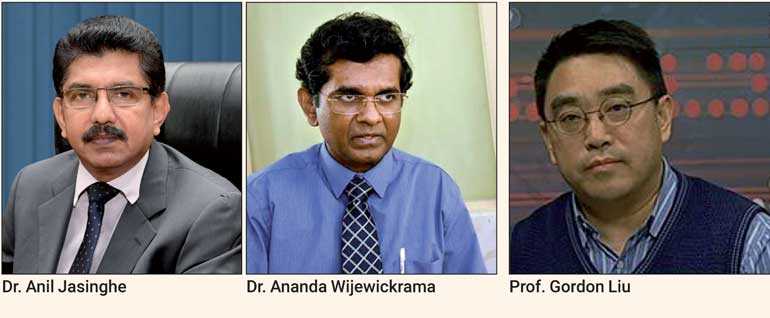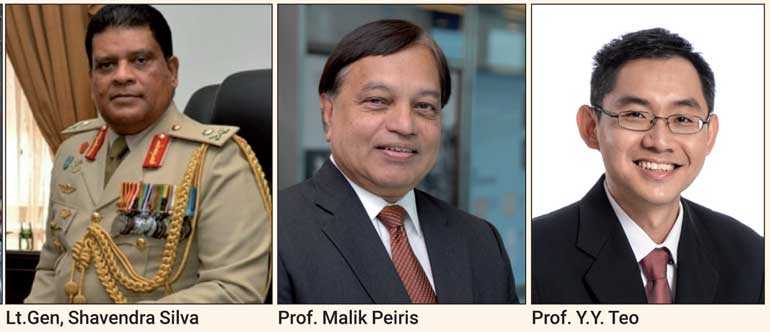Monday Jan 13, 2025
Monday Jan 13, 2025
Friday, 1 May 2020 00:00 - - {{hitsCtrl.values.hits}}


As Sri Lanka looks to ease curfew, the Government will need to be nimble in its policymaking if it is to balance economic recovery with effective COVID-19 mitigation, medical experts said yesterday, calling for ramping-up of testing and strictly enforcing social distancing guidelines, warning two-thirds of local patients were asymptomatic at the time of testing.
Titled ‘Breaking the Transmission Chain through Community Empowerment,’ the panel discussion organised jointly by the Sri Lanka Medical Association (SLMA) and the Asia-Pacific Academic Consortium for Public Health (APACPH) was held in Colombo yesterday.
The first-ever virtual international conference on combating COVID-19 in the Asia Pacific Region saw healthcare professionals from Singapore, China, Malaysia, Hong Kong and Australia join their Sri Lankan counterparts in discussing a way forward from this global crisis.
Gradual easing of restrictions
The overwhelming sentiment among the panel was that despite the best efforts of many governments, with a vaccine at least over a year away, a gradual easing of curfew and social distancing restrictions would be unavoidable over the coming months so as to stave off economic turmoil.
The gravity of the task at hand was perhaps best encapsulated by one of the world’s most renowned experts in virology, Prof. Malik Peiris from the School of Public Health in Hong Kong University. According to Prof. Peiris, the only way to bring the situation under control would be through gathering immunity. He elaborated on this concept using an analogy of a car going downhill, where brakes have to be applied and relaxed intermittently.
“If we notice the outbreak is re-emerging, then the measures will have to be reintroduced,” explained Prof. Peiris.
In terms of pure numbers though it was Prof. Gordon Liu from the Peking University in Beijing, China, who made the most compelling point, arguing that a move towards mass testing would prove more prudent in both the short- and long-term.
COVID-19 testing kits have been notoriously difficult for countries to get a hold of, primarily due to their prohibitive cost; many countries, especially developing nations, have felt money could be better spent elsewhere. Prof. Liu disagrees.
Mass testing helps gain economically
“You can take three types of action,” explained Prof. Liu. “Moderate action is based on symptoms, such as identifying cases through temperature tests, etc. Then you have surgical action, which is essentially a lockdown. This, while effective has a huge error, because you punish people who are ‘innocent,’ and then the economy suffers. But with mass-testing we can be more proactive in finding where the hidden enemy is.
“This virus is quite different from SARS which developed symptoms quite quickly. If we can mobilise resources to conduct as many tests as possible, that option in my view would be better than anything we can think of.
“In China, my calculation is that about 2-3% of GDP - $ 500 billion – is being lost because of the lockdown. If we take $ 20 per test and multiply it by 1.4 billion that’s $ 22 billion – that’s a small proportion and it’s a much higher yield. You will always gain economically by mass testing as opposed to other measures.”
According to Dr. Ananda Wijewickrama, the Chief Consultant Physician at the National Infectious Disease Hospital, Sri Lanka has so far conducted around 20,000 PCR tests, and in the process identified, as of writing, 649 confirmed cases. However two-thirds of those who contracted the virus in Sri Lanka tested positive despite being asymptomatic, according to Dr. Wijewickrama.
Enhance capacity and decentralise testing
According to Prof. Peiris, Sri Lanka’s testing capacity is “adequate” for the time being, but he urges the country utilises the time period when the outbreak is under control to enhance capacity and decentralise testing.
“It has to be decentralised so you don’t waste time transporting specimens,” stated Prof. Peiris. “But I think at the moment Sri Lanka’s testing capacity is adequate, and there will be periods where the outbreak increases. I think now is the time to try to enhance your capacity further and decentralise it as well.”
As it stands, only those who show symptoms can be tested for the coronavirus in Sri Lanka; the reason asymptomatic carriers were identified and tested in the country is primarily down to the Government’s heavy focus on contact tracing.
Contact tracing leads to success
Alongside his post as Chief of Defence Staff and Commander of the Sri Lanka Army, Lt. Gen. Shavendra Silva heads the National Operations Centre for Prevention of COVID-19. Under his guidance, the armed forces have installed over 50 quarantine centres islandwide, which has seen nearly 10,000 quarantined people since the outbreak began.
Much of the Government’s success in preventing the spread of the virus has been down to contact tracing, noted Lt. Gen. Silva.
“If a person was confirmed, then we found every person they had been in contact with, and those people were then asked to self-quarantine themselves in their houses,” explained Silva.
This method of identifying potential cases has seen the Government identify multiple ‘clusters,’ according to Director General Health Services Dr. Anil Jasinghe.
“We have been able to finish off those [eight] clusters,” explained Dr. Jasinghe. “There were two more bad clusters in urban areas, but even those clusters we have been able to achieve success of maybe 90-95%. So there’s now relatively normal life in those areas.”
Self-discipline and aggressive social distancing key
For Sri Lanka, which has been gradually looking to ease curfew measures, the best example might come from Hong Kong. To date Hong Kong is yet to impose curfew or lockdown measures, instead relying on the public to maintain strict social distancing guidelines, while at the same time encouraging ‘working from home’ whenever possible.
Hong Kong hasn’t seen a new case in the last five days as of writing, with its second peak arriving through March into early April, as students returned from abroad. According to Prof. Peiris, a large reason for its success in flattening the curve has been public cooperation in the Government’s guidelines.
“Our local transmission was stopped by closing public facilities and hospital visitors were stopped. PCR testing was then ramped up and extended to accident and emergency units and then to private practitioners. It’s important to note that Hong Kong has never been in a lockdown like many other countries, no curfew either,” he noted.
“But what we have had is very aggressive social distancing measures. But the importance of public participation has been very important. The attitude towards this has improved very dramatically.”
For his part Lt. Gen. Silva said he was aware of how important public cooperation was in securing his ultimate stated goal of “preventing the spread of the virus”.
“Self-discipline of individuals is key, without which you can’t do anything,” he stated. “You can bring the best practices but they will not be enough unless every individual is of the mindset ‘I will not get infected, and I will not infect’ – that is the greatest duty every citizen can have.”
However, if early signs are to go by, such as the overcrowding of buses over the last week, then the message is likely not getting across as effectively. In Singapore, where discipline and structure are a part of everyday life, communication makes up one of three pillars in its strategy for countering COVID-19. The other two are effective testing and contact tracing, and adopting a data-based approach.
Clear communication vital
According to Prof. Y.Y. Teo, the Dean at Saw Swee Hock School of Public Health at the National University in Singapore, testing is non-negotiable, while the use of statistical models helps identify the spread of the virus along with the fraction of the population still susceptible to infection. However it’s the communication strategy that ties everything together.
“Clear communication to the public remains vital. What is the situation, what are the measures, what are the new regulations – these change with time, and it’s paramount that all members of the public are kept aware of the situation at all times.”